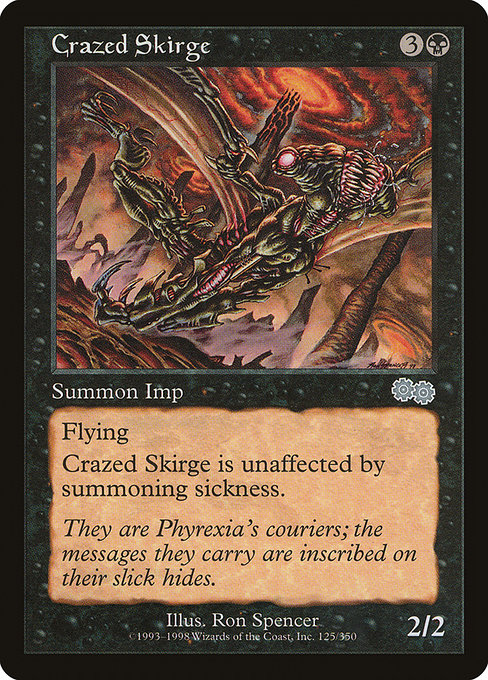
Image courtesy of Scryfall.com
Crazed Skirge and the Psychology of MTG Chaos
Magic: The Gathering has always thrived on a delicate dance between order and chaos. On one side you have carefully constructed decks, tight mana curves, and precise timing. On the other, you encounter the thrill of chaos—randomness, dramatic swings, and the kind of design that makes players lean in and say, “What was that move just now?” Crazed Skirge—a little black flyer from Urza’s Saga—serves as a perfect case study for how design chaos reveals human behavior at the table 🧙♂️🔥.
First, the card itself is a study in tempo and risk. For four mana, you get a 2/2 creature with flying and haste. In a Black-dominated color identity, that’s not merely a vanilla beater; it’s a catalyst for early, aggressive turns that pressure opponents who aren’t ready to handle evasive threats right away. The haste clause nudges players to think in the moment, to reward decisive play rather than patient, methodical planning. The result isn’t just a physical card slamming into a battlefield—it’s a psychological nudge toward bold decision-making. Players who prefer the safety of a clean board state might second-guess their blockers, while risk-takers lean into the chaos and swing for a fast win or a daring stall-breaker. The impulsive thrill of throwing a 2/2 into the air and hoping it lands a hit is a quintessentially human response to uncertain outcomes 🧠💎.
From a pure design perspective, Crazed Skirge embodies the charm and danger of the era. It hails from Urza’s Saga, a set famous for its heavy leverage on artifacts, color identity, and the open chaos of late-’90s MTG—where power and silliness danced side by side. The card’s rarity—uncommon in a set full of legendary moments—reads like a wink from the designers: “Here’s a cheeky piece that can surprise you in the right moment, but isn’t asking you to break the bank.” The flavor text—“They are Phyrexia's couriers; the messages they carry are inscribed on their slick hides.”—grounds the card in a lore of unsettling efficiency and a touch of horror. That lore matters, because it informs how players respond to the card in retrospect: do you treat it as a simple tempo play, or do you imagine the ominous courier delivering a new threat every time it takes the field? It’s this blend of flavor and function that seeds chaotic thought experiments at the table 🎨⚔️.
“They are Phyrexia's couriers; the messages they carry are inscribed on their slick hides.”
Humans are pattern-seekers, and chaos in MTG ruthlessly tests our pattern recognition. When a four-mana 2/2 with flying and haste lands, it doesn’t just threaten damage; it unsettles anticipated game states. Do you hold up, hoping for a blocker on the next turn? Do you press your own line and capitalize on the surprise tempo? The instant feedback loop—your opponent reevaluating their plan the moment the Skirge declares combat—reveals our bias toward short-term gains versus long-term board control. Some players chase the immediate advantage, even if it yields a brittle advantage later. Others become allergic to risk, preferring to stabilize and plan for the late game. This split is a tiny microcosm of human behavior under uncertainty 🧭🧙♂️.
What makes Chaos in design so enduring is precisely this social experiment embedded in the card’s sheet music. A single card can tilt the mental model of an entire game: it invites you to deviate from your “optimal” plan, to embrace the uncomfortable possibility that something surprising might occur. In the modern era, designers push this impulse further—with chaotic draft formats, modal spells, and cross-format chaos engines—but the core principle remains: players improvise, adapt, and justify the risk with a mental calculus that’s part strategy, part psychology. Crazed Skirge acts as a friendly, tangible reminder of why we play: the joy of reading a situation correctly, the adrenaline of a well-timed attack, and the shared laughter when a bold move pays off or a ridiculous bluff shatters a plan 🧠🔥.
Let’s talk about the art and lore as a bridge between game design and player psychology. Ron Spencer’s illustration gives the Skirge a kinetic appetite for mischief—tiny, sharp wings beating a chaotic rhythm as it zips toward the horizon with predatory intent. This aesthetic choice reinforces how players remember the card: not as a mere number on a card, but as a story you can retell around the table. The flavor text anchors that story in Phyrexian lore, a lineage of relentless efficiency and grotesque elegance. When you pair flashy mechanics with evocative art, you’re inviting players to inhabit the card’s world. That immersion, in turn, heightens the emotional stakes of each play, which is exactly where chaotic magic thrives 🖼️🎲.
Why this matters beyond nostalgia
Today’s designers observe how old chaos-designs like Crazed Skirge sketch out the boundaries of human behavior under pressure. They reveal the psychology of risk-taking, the social dynamics of a multiplayer game, and the enduring lure of a well-timed surprise. The card’s black mana identity cements a cultural memory: in black, you’re often playing with risk as a resource, trading safety for speed, and trusting that timing, not brute force alone, will swing the table in your favor. That philosophy—embracing risk as a driver of excitement—permeates contemporary design, where chaos is not a glitch to be fixed but a feature to be mastered 🧙♂️⚡.
For fans who want to celebrate the chaotic spirit in a tangible way, consider how everyday objects around you mirror that same energy. And speaking of tangible, if you’re looking to deck out your everyday carry with a dash of neon flair while you brainstorm wild deck ideas, check out this neon slim phone case for iPhone 16—glossy Lexan goodness that’s as bold as a Skirge swing. It’s a small nod to the same design ethos that keeps MTG vibrant: unapologetic style meets practical function, a little bit of risk, and a lot of personality 🔥💎.